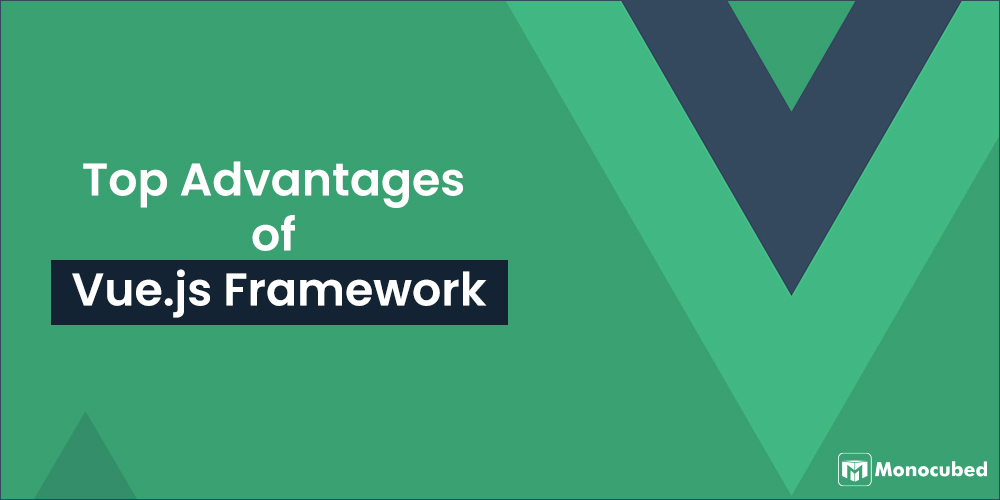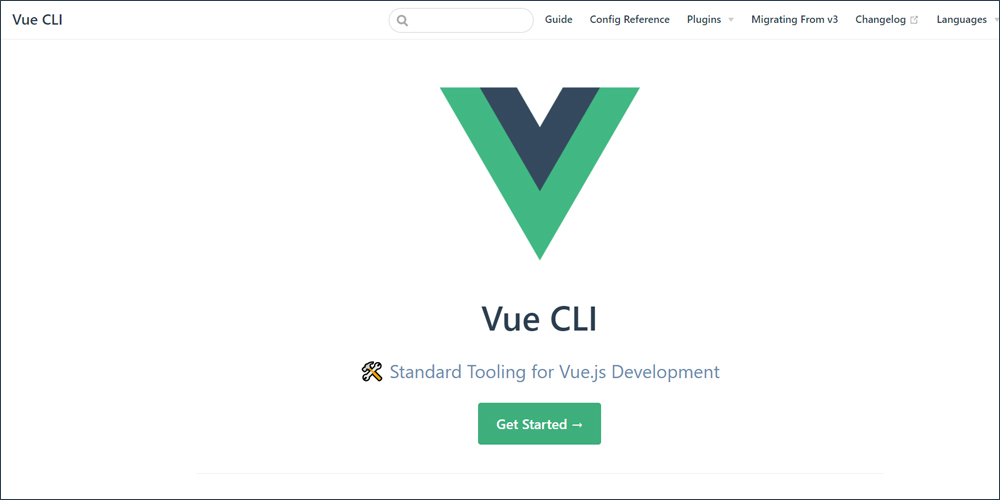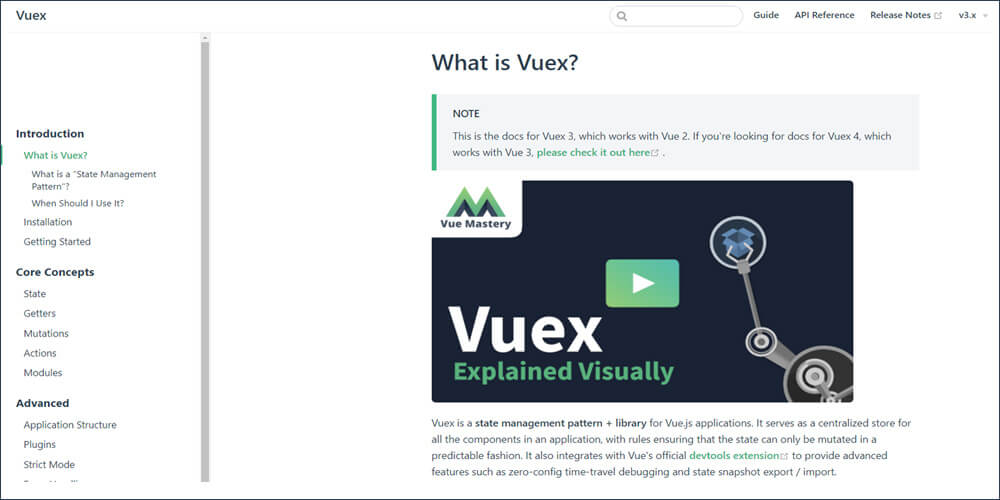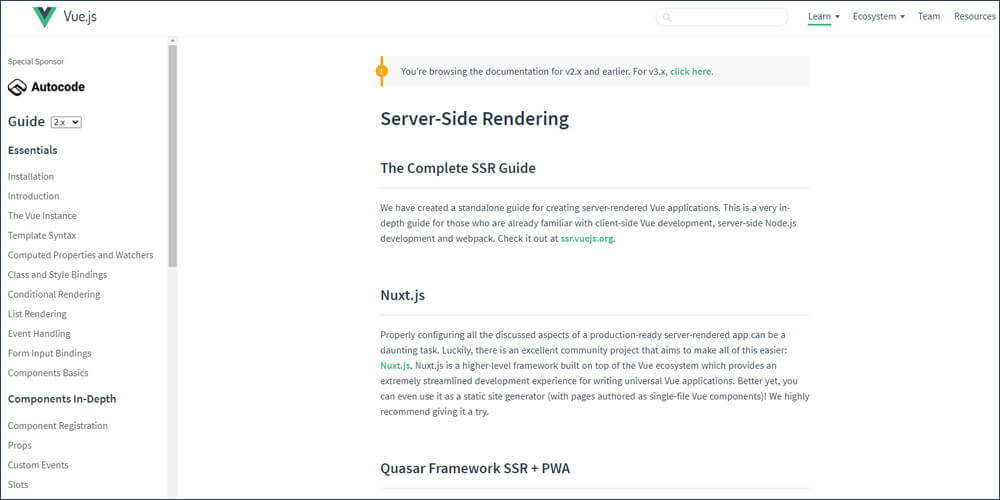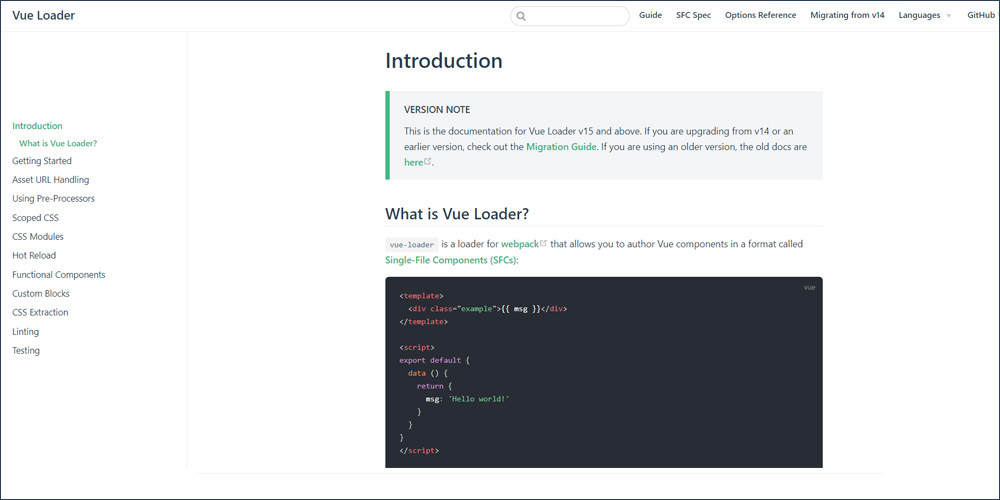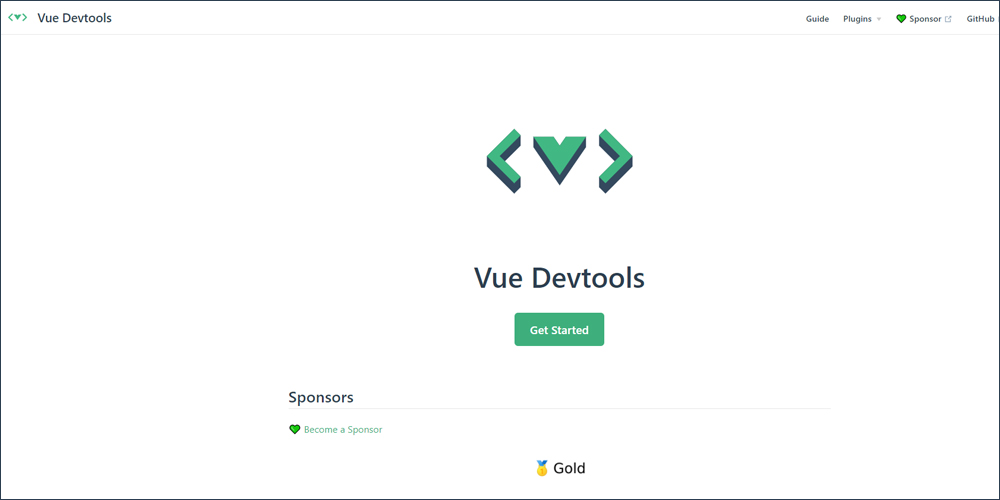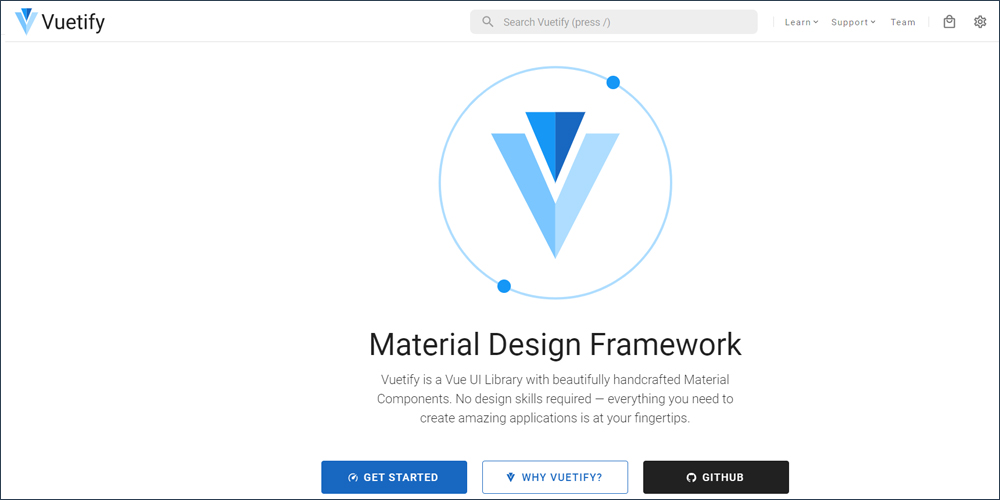The web development field is undergoing a massive change in the last few years. New technologies and tools are being released every month to ease the web app development process.
One such new framework is Vue js. Although it was released in recent years, it has quickly become one of the most popular JavaScript frameworks for frontend developers.
In this blog, we will be looking at all the advantages of Vue js framework. Along with this we also discuss why Vue js has gained so much popularity in such a short time. But first, let’s have a brief overview of the framework.
Table of Content
Overview About Vuejs Framework
Vue js is a progressive framework designed for the frontend development of web applications and websites. It follows the Model–View–View-Model (MVVM) architecture and is mainly used for building user interfaces and single-page applications.
Created by Evan You, this lightweight, easy-to-use framework focuses on the View or Presentation layer of a web page. That is it takes care of everything that a user will see when visiting your website, be it the graphics or the clickable elements, or the login page.
For advanced functionalities like URL mapping, routing, and state management you can use the Vue Ecosystem tools, all maintained by the official development team.
Advantages of Vue js in Web App Development
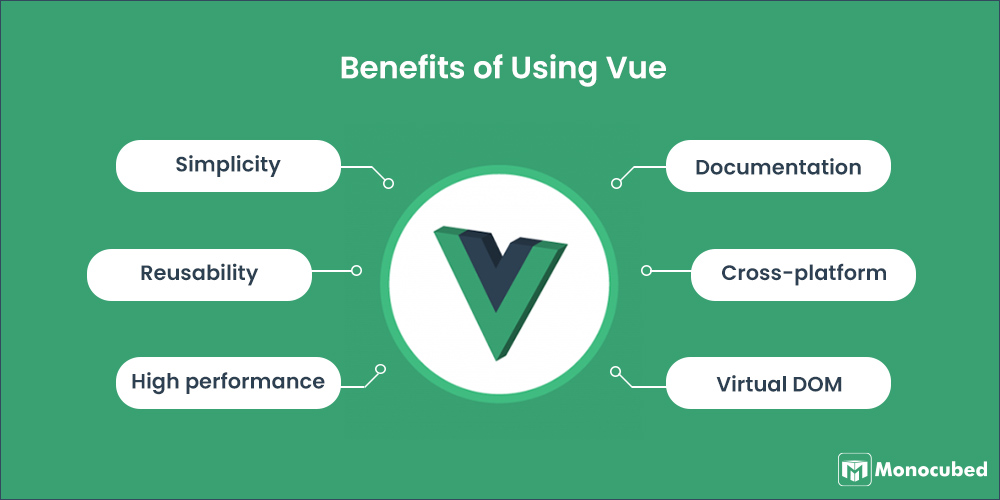
Vue is widely popular and gaining a lot of traction in the field of front-end development. But choosing a technology just because it is trending is not enough.
So let’s look at the advantages the Vuejs framework offers that make it a good choice for your business.
Simplicity
You can write your Vue app within 5-6 code lines. Vue streamlines the web app development cycle by doing automation tasks under the hood such as:
- It links the data to DOM automatically
- Takes care of configurations
- Create watchers for each component
It takes care of all the disadvantages of Angular, creating a lightweight, simplistic framework for the frontend development of web apps and websites.
Component-based architecture
Like Angular and React, the Vue js framework follows a component-based architecture. This means all the frontend application code can be divided into independent components.
These components, consisting of template, logic, and styles, are bound together to form the web app.
In addition, the web framework automatically divides the JavaScript, CSS, and HTML code. Thus there is no need for developers to create separate files for CSS styles or HTML elements.
Vue components are portable, reusable, and easily tested.
Reusability
The component-based approach of Vue enables the formation of reusable single file components. Inside a component, template, logic, and styles are inherently coupled.
Instead of separating the code into arbitrary layers, Vue collates components that can be reused and into a function.
This makes the UI component cohesive, portable and maintainable.
Reusing the components imply-
- less repetitive coding
- increases code readability
- simplifies testing and maintenance
High performance
Vue js framework is extremely lightweight, bundling around 20KB. But it doesn’t compromise on performance or productivity. It is one of the fastest frameworks available for building web interfaces.
With such minimal characteristics, Vue js is lightning-fast to install and you can start working in a matter of minutes. Plus, the high page loading time also positively affects your web pages’ SEO ranking.
Want to Grab Your User’s Attention?
Talk to us and develop a rich, attractive UI-UX design using Vue that grabs your user’s attention. Let’s start designing.
Documentation
Documentation is a very essential part of any framework or library, especially if you are a beginner and new to the technology. Compared to other JS frameworks, Vue js possesses extremely detailed documentation.
Along with an introductory guide, the Vue documentation gives a good overview of the working of the framework. It provides information for the simple installation process and even includes a detailed Vue comparison with other frameworks such as React, Ember, and AngularJS.
With clear and concise explanations of each feature and concept, Vue’s documentation is a one-stop solution to any problems you might face.
The documentation is also constantly updated to reflect recent changes and best practices.
Cross-platform
Vue developers are able to use the cross-platform UI framework Weex for native app development. Created by Alibaba Group and being incubated by the Apache Software Foundation (ASF), Weex allows you to use the same code across different platforms.
The same component syntax that you use for websites, can be applied for native mobile apps for iOS and Android. This greatly reduces the work of your development team and ensures a faster time-to-market.
Frameworks and libraries
Vue has amassed a large number of external libraries and frameworks for developer’s ease. Some popular ones are –
- Nuxt.js is a framework for Vue that is designed to develop performant web applications. Using the philosophies of Next.js and Vue. js, Nuxt employs a modular architecture. You can use it for SPAs, static websites, PWAs and universal Vue apps.
- Bootstrap-Vue is a plugin for the development of Vue applications using Bootstrap components. It combines Vue.js with Bootstrap, the most popular frontend CSS library, and is a popular choice for mobile app development projects using Vue Native.
- Nuxt.js is a framework for Vue that is designed to develop performant web applications. Using the philosophies of Next.js and Vue. js, Nuxt employs a modular architecture. You can use it for SPAs, static websites, PWAs and universal Vue apps.
Virtual-DOM
Vue js uses a virtual representation of the actual DOM of a webpage, created using Javascript objects. Thus the DOM objects can easily be rendered without modifying and refreshing the whole tree every time.
But, what is DOM?
A Document Object Model or DOM represents various HTML pages providing information about its elements, styles, and content. These DOM objects are stored in the form of a tree structure. A browser uses this tree for rendering web pages.
But, in a modern application that has many features, the DOM tree can get extremely huge with multiple nodes. Interacting with this DOM can become a cumbersome process affecting web app performance.
Reactive two-way data binding
This is the most important feature of Vue.js. With Virtual DOM and the two-way binding feature, Vue.js ensures minimal coding for the developers.
A developer can make changes in the Model layer or the View layer, and the Vue.js framework will make the changes in the other layers. It will keep your code (variables and array values) in-sync across the whole application.
This ensures your data remains consistent. You will be able to save a lot of time and costs in the debugging and testing phase.
Declarative rendering
The core of the Vue.js system lets you render data declaratively to the Document Object Model. Using simple templating syntax, Vue simplifies the process of rendering web pages.
You can write templates using JavaScript programming language, HTML, or JSX, an XML-based JavaScript syntax extension.
What is declarative rendering?
In imperative rendering, the components are pushed data, that is they receive data from higher components. But in Vue, elements request data and pull only the required information. This means, all the properties of an element would be defined in a single function. So it becomes easier to manipulate or modify a particular element.
If these advantages weren’t enough to convince you, we have discussed the robust ecosystem of Vue.js in the next section.
Vue Ecosystem
The Vue.js ecosystem consists of a core library, frameworks, and other tools that enable frontend development with ease and high speed.
Although Vue, itself is lightweight and minimalistic, it gives all the tools to developers for creating high-functioning web apps.
Vue CLI
Source: Vue CLIVue CLI is the standard tooling baseline for the Vue js framework. It provides a set of tools specifically designed for making working with Vue easier. It takes care of integrating tools with defaults so you can focus on your web app.
The Command-Line Interface comes with a project generator that reduces the time developers spend on initial project setup and scaffolding. Other functionalities it offers are –
- Project scaffolding
- Official tools and plugins that enrich the Vue ecosystem
- Support for Babel, TypeScript, ESLint, PWA and PostCSS
- Unit testing & end-to-end testing supported so that your debugging process is quick and simple
- Rapid prototyping without requiring to code any configurations
- A full graphical user interface for frontend development
Router
Source: Vue routerVue Router is the official router for Vue.js development. It helps show the correct view when you hit a specific URL.
A router syncs the currently displayed view with the browser address bar content. In other words, the router changes the URL, when a user interacts with the web page by clicking on links.
However, Vue does not enforce this library, allowing the developer to use any other generic routing library. But we recommend using Vue Router as it ensures seamless integration with your web app. Plus, as part of the ecosystem, it is not going to become incompatible with future updates of Vue.js.
Vuex
Source: VueXVueX is a state-management library for Vue.js. It integrates with Vue applications creating a clean, isolated interface for binding your stubbed data to web API data.
Libraries like VueX make it possible to manage shared states across components in a structured and maintainable way. It creates a global state tree that can be accessed and updated by every component in a progressive manner.
Vue Server Render
Source: Vue Server RenderVue.js is a client-side framework that works only on web browsers. By default, components interact with the DOM tree in the browser to provide output. But using Vue SSR, you can build server-side applications too.
SSR Vuejs apps can be considered universal apps as they work on both client-side and server-side. Using Vue SSR over single-page applications can prove to be very useful in terms of better SEO, faster page load times, and higher time-to-content rates.
Since the application does not require all the JavaScript to be downloaded and loaded, the web application renders promptly, providing a much better user experience.
Vue Loader
Source: Vue LoaderLoading webpack into your application can be achieved using Vue Loader. The webpack helps you host all your Vue components in a format called the Single File Components(SFCs).
When you combine webpack with Vue-loader, your productivity will increase exponentially. It allows you to create custom CSS for each component, handle static assets, and even offers support for other webpacks to build an extremely flexible, and powerful front-end workflow.
DevTools
Source: Vue-devtoolsVue-devtools is a browser extension that is used for inspecting and debugging Vue.js web applications. It can be used for inspecting components, events, and states in your application.
Vuetify
Source: VuetifyVuetify is a UI component framework built on top of Vue.js. Based on the Material Design specification, it provides developers with the tools they need to build rich and engaging user interfaces.
Although Vuetify is not an official part of the Vue ecosystem, its popularity and usage have made it a go-to choice for Vue developers.
It requires no prior experience with designing as Vuetify is designed for developing Vue js applications in a simple and attractive manner.
Vuetify is mobile-friendly. It allows you to develop cross-platform websites using Vue.js that work seamlessly on a web browser as well as a smartphone or a tablet.
Looking for a Mobile-friendly Website?
Our frontend developers can help you develop a custom website that works perfectly across all devices- smartphones, tablets, and PCs.
But what makes Vue different? Why are developers switching to Vue?
Why is Vuejs so Popular?
Having 184K stars on Github, Vue is one of the most popular JS frameworks, surpassing even React and Angular having 168K and 73.5 K stars each.
Vue is used by big companies such as Gitlab, Alibaba, Xiaomi, Adobe, Euronews, Nintendo, Grammarly, and Codeship.
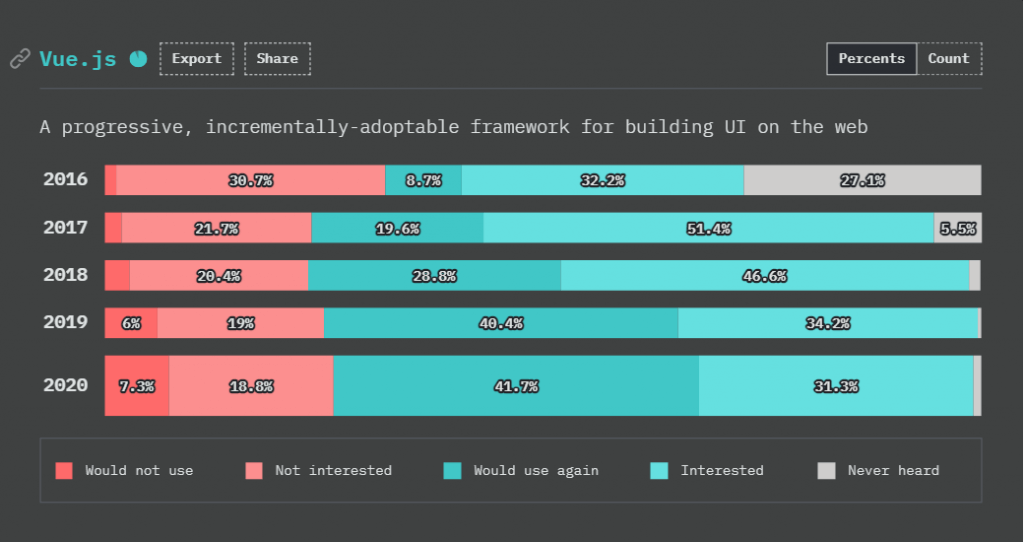
Many developers are shifting from React and Angular to Vuejs because of high flexibility, improved performance, and easy integration of existing applications and component libraries.
Vue makes it quick and simple for developers to adapt and implement common features every app requires.
The ever-rising popularity of Vuejs can be understood by the many advantages it offers to the users.
- Combines the best features of Angular and React JavaScript frameworks. It is a lightweight, component-driven frontend framework that includes integration capabilities, high performance and simple template syntax just like Angular. At the same time, it offers state-of-the-art state management, reactive data binding, and virtual DOM rendering concepts of the JavaScript library, React.
- Provides high flexibility to developers
- At the same time, it comes equipped with a lot of under-the-hood defaults. This means Vuejs will automatically implement common tasks to reduce development time.
- It has an extremely smooth learning curve. Newbies can start working with this JavaScript framework in a matter of days and even experienced developers can adopt it very quickly.
- It is lightweight and minimalistic, not requiring a lot of space. But at the same time, it doesn’t compromise on any functionality. It provides plugins and third-party libraries that can take care of all frontend applications.
- It has an extremely well-defined ecosystem. With a powerful command-line interface, Vuejs increases developer’s productivity. Other powerful tools in its ecosystem include a server-side renderer, loader for webpack, and a state management library.
- It is extremely scalable. It can be used as a library or a framework depending on the requirements of the web project.
- Vue js has also amassed great community support in a very short span of time. With active members on GitHub, Discord and discussion forums, you can get immediate support from experts in case of any problems.
- It is supported by some of the most popular code editors such as Atom, Sublime Text and Visual Studio Code. You can use this popular framework with JavaScript code editors.
Frequently Asked Questions
What is Vuejs?
Vue.js is a dynamic JavaScript frontend framework that is used for the development of interactive User Interfaces(UI). The framework allows developers to develop single-page applications, powerful websites and even desktop and mobile applications. Vuejs is progressive, simple, portable and extremely lightweight.
Is Vue.js worth using?
Vue is an exceptional framework that aids developers in building dynamic, user-centric web applications. It is lightweight, extremely easy to learn, flexible, highly modular and comes with a robust ecosystem. The framework uses Virtual DOM, declarative rendering, and two-way data binding to enhance performance and speed of the web app.
Is Vue.js better than Angular and React?
Vue.js is one of the top front-end JavaScript frameworks of 2026. It has a smoother learning curve and provides higher flexibility to the developers. Compared to Angular, Vue.js is lightweight, more performative and less opinionated. Vue is more similar to React but is still easier to learn. The templating system and component-driven architecture of Vue.js makes it more simpler than React.
Conclusion
Vue.js is a progressive framework that is used for the development of performative web applications. There are many advantages of Vue js that make it an ideal choice for building user-driven web applications that have high speed, smooth navigation, and intuitive user interactions.
Do you have an idea for a web application? Contact our team of experts and get a free session with our IT consultant. We can help you streamline your Vue development process and build engaging web applications.
 By Yuvrajsinh Vaghela
By Yuvrajsinh Vaghela
